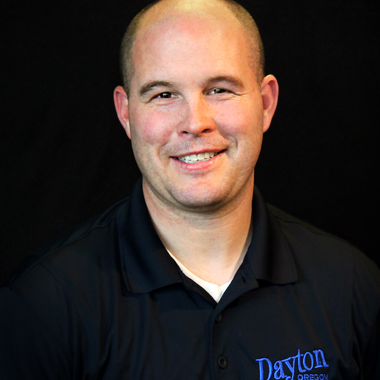
Scott Pingel, city manager, Dayton, Oregon,objected to spending time writing briefs and searching for billable hours when deciding what to do with his political science degree from Brigham Young University. Scott yodeled from atop the Y Mountain and “city manager, manager” echoed in return. Scott researched what a city manager was and his excitement for public service fueled his trip eastward to West Virginia University where he earned his MPA in 2007.
The newly-minted Mountaineer quickly scaled the ranks of public administration and city management. For two years, Scott acquired practical knowledge as an ICMA Local Government Management Fellow for the city of Federal Way, Washington. A short stint as a performance measurement consultant in Richland, Washington, paved the way to Scott’s appointment as city manager of Stanfield, Oregon, in January 2010. Getting ever so close to the Pacific Ocean, Scott ventured westerly to Dayton where he has served as city manager since March 2013 and he and his wife Lindsey became parents for the fifth time.
Pint-Sized, Gallon-Filled
What Dayton lacks in population size – home to approximately 2,600 residents – it makes up for in location, history, and offerings. An hour’s drive from Dayton will take residents to Portland for city amenities or building sandcastles. Short on time? Thirty minutes from Dayton, one can head to Salem, Oregon’s capital, to watch precedent set. But come on back to Dayton to sip on some Willamette wine and experience a different type of history.
Founded in 1850, Dayton enjoys more than 40 historical places listed on the National Registry of Historic Places. The abundance of these places designated Dayton as the first historic resource in the state of Oregon. Included on the registry is Courthouse Square, within which a remodeled bandstand amplifies the sounds of laughter and music. Park the jalopy and hop on the walking tour that Dayton offers of all its historic properties. Or shine the whitewalls and cruise-in on Friday nights between Memorial and Labor Day for Downtown Dayton. This weekly event showcases live music, park vendors, and business specials.
Scott has working experience in both larger and smaller communities. He shared that in a smaller community, like Dayton, he “wears several hats” and works in what seems like a doorless 24-hour office (think the Cheers theme song). Slumber parties at the Pingel house include Scott’s daughter’s best friend forever – the daughter of a city council member. In a larger community, like Federal Way (population approximately 93,000), Scott could consult with numerous other employees who had expertise in a specific subject if he encountered a problem. Dayton employs nine individuals.
Nature Finds a Way
Trees grow alongside the thriving businesses in downtown Dayton like many other communities. While displaying festive foliage, these arbor amigos were not playing nice as they had severely dislodged sidewalks in front of the businesses. Since a downtown rollercoaster had not been approved by the council, Scott worked closely with all of the downtown businesses to replace all the downtown sidewalks and the street trees. In fact, all of the downtown businesses bought into the project so that the sidewalks were replaced uniformly. At least in downtown, sidewalks only needed repair.
Doc Brown, in Back to the Future Part II, responded to Marty foreshadowing, “Where we’re going, we don’t need roads.” Dayton had enough roads leading to the elementary school but unfortunately no sidewalks. In the real 2015, true hoverboards don’t exist so schoolchildren found themselves walking near speeding DeLoreans. The city unsuccessfully applied for state grant money but was undeterred. Dayton attempted to extend paving beyond the highway to serve as a makeshift barrier for the children. The state finally recognized the safety issue and granted Dayton full funding to construct sidewalks and to engineer all the required storm drain improvements.
A Partner to Trust
Government, at all levels, easily receives the enemy moniker. Scott recognizes that local government sits in the unique position to partner with residents as a means to gain trust. He said, “More at the local level than any other, local governments have the opportunity and capacity to turn such attitudes around. It requires our local government leaders to be unifiers. We have to be effective liaisons for our councils, staffs, and residents. Trust can be a huge help in fiscal and social matters, but public servants have to prove worthy of that trust, and that has to start with us as local government leaders.” Scott believes that personally interacting and being accessible outside of city hall hours garners the community’s trust. Putting words into action, Scott even pumped up his Reeboksä and hit the ground running to speak with homeowners, at their homes, about the elementary school sidewalk project.
Scott has been an ICMA member since being an ICMA Fellow and will complete his tenure as a board member of the Oregon City/County Management Association later this year. Scott credits these associations for providing “…a sound framework for me to work within and serve my residents and fellow managers.” Scott believes that abiding by the ICMA Code of Ethics is important as well as its enforcement. He projected, “The code is not just about what we aren’t supposed to do, but it is also about the professionalism with which we should approach our jobs and the things we are committed to doing as local government professionals.”
New, Reduced Membership Dues
A new, reduced dues rate is available for CAOs/ACAOs, along with additional discounts for those in smaller communities, has been implemented. Learn more and be sure to join or renew today!
